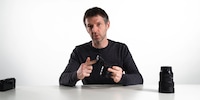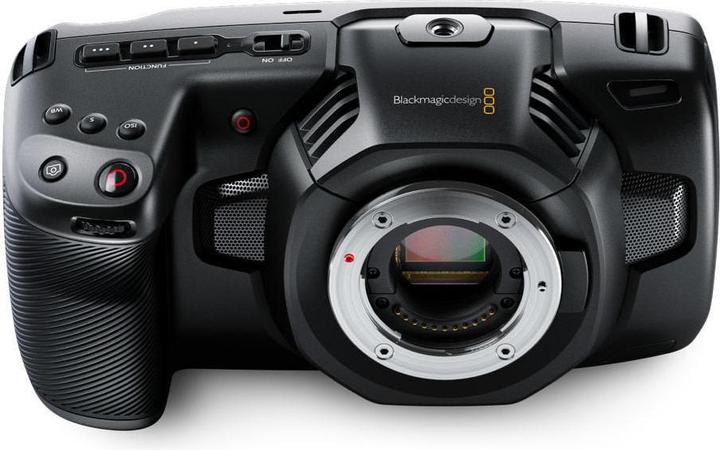

Blackmagic Pocket Cinema: The most affordable cinema camera in use
The handy and affordable professional cinema cam has finally arrived. To make the test as realistic as possible, I tried it out on a real video project.
I've been waiting months for the Blackmagic Pocket Cinema Camera. Now it's finally on my desk. I feel like a little boy at Christmas. The camera promises a lot for little money. A lot, in fact. We test the handheld cinema camera on a shoot in Ticino together with a professional climber.
We are the main actor and climbing pro Kevin Huser, his mate Vladek Zumr, Patrick Bardelli from the Galaxus editorial team, Luca Steiner, who always supports me with film work, and me. We meet the evening before the actual shoot, all with our campers, in a car park in Brione TI. We get to know each other better over a beer and some delicious pasta. Discuss the next day. We have a lot planned. Vladek is a climbing photographer and suggests we take a few night shots on a nearby rock. Kevin joins in and we watch the spectacle as spectators.

Source: Vladek Zumr / vladekzumr.com
Now from the beginning again
The delivery times for the camera are unbearably long. Mine only arrived around four months after I ordered it. I was all the happier for it. A firmware update is already available on the Blackmagic servers. It is now possible to record Blackmagic RAW. This format can be highly compressed. Very high RAW quality can be recorded with comparatively low memory requirements. With my 64 GB memory cards, I can record just under 40 minutes of RAW footage with 1:12 compression and 4k at 25 fps. With the best RAW quality, around nine minutes are possible.

The camera would actually have to be inserted into a cage in order to use all accessories. Not even a hot shoe adapter is integrated. So I order an adapter that I can screw into the top of the threaded screw so that I can then attach a microphone or a screen via a hot shoe. Unfortunately, we don't have any cages for the Blackmagic in our range.
Buying the camera is not the end of the story. You should set aside at least a few hundred francs for various accessories.

The camera draws an incredible amount of power. I can only film for 30 minutes on the one battery supplied. That's why I want to charge the camera with power banks via the USB-C input. An hour before leaving for Ticino, I try it out and realise with horror that the camera is not being charged. An agitated phone call later, I am reassured. Luca has a solution - his power banks have an output voltage of up to 12V. So it works.
The alarm clock rings
It's early in the morning in the car park in Brione. Everyone is still asleep. Only Luca and I are already standing with the tailgate open, mounting the camera on the DJI Ronin S gimbal, taking a few shots of the peaks already illuminated by the sun and launching the drone. The light is beautiful. You never know - we might be able to use the shots.

At last, the other three crawl out of the duvets. We immediately grab Kevin and start filming. Meanwhile, Patrick and Vladek make coffee and prepare breakfast.
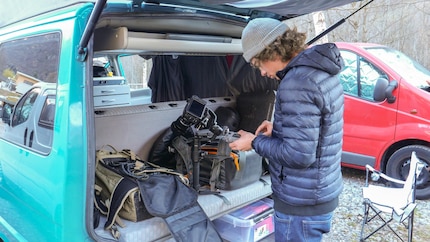
Stabilised shots and their pitfalls
Placing the rather large and wide camera on the Ronin-S gimbal turns out to be more difficult than expected. Fortunately, I've already tested everything in the office. I have to redirect the tripod quick-release plate over a second plate to be able to place the camera on the gimbal. There's no other place for it. When shooting, it is very difficult to keep the focus on the desired object. Unfortunately, the focus wheel does not work with the Blackmagic. An external focus wheel that is not controlled by the software would be the solution. Best operated by an additional focus operator. For the climbing shots, we do without the gimbal and film from the hand. The view of the screen is completely clear and it's easy to set the focus on the relevant object.
An almost perfect overall package
With the Blackmagic camera, you don't go out and take photos. It is designed for film. This can also be seen in the various connections (mini XLR input including phantom power, full HDMI output, etc.), the huge touchscreen on the back or the fact that the camera is dual ISO capable.
In a climbing film like the one we shot, it is extremely important to be able to act quickly and be flexible. We also achieve this flexibility thanks to a very versatile lens. The Olympus 12-100mm f4 lens (equivalent to full-frame 24-200mm) is the perfect companion.
The sensor of the Blackmagic is not stabilised. Fortunately, the lens is and so even fully zoomed shots can be taken handheld. Without image stabilisation, a tripod, slider or gimbal would be required in any case. This may work for a scripted film. Not in our scenario.
In addition, the Blackmagic has a simple integrated autofocus. I can use this to focus on a static object. There is no continuous autofocus, as I am used to with my Sony a7s ii. Manual focussing is necessary in our case. All other settings such as ISO, aperture or shutter speed are also set manually.
RAW images are quite data-hungry. In the format with the best quality (Blackmagicraw 3:1), around 9 minutes of film in 4k and 25 fps fit on a 64 GB card. With 12:1 compression, just under 40 minutes fit on the card. RAW is compressed accordingly. A video recorded in 12:1 has a bit rate of 46 MB/s - at 3:1 it is 183 MB/s and an uncompressed RAW file has a bit rate of 548 MB/s (at 4.6k and 30 fps) However, you have the advantages and freedom of RAW at all compression rates.
Mavic 2 Pro: works even in strong winds
In the afternoon, the wind gets stronger and stronger. We launch the Mavic Pro anyway - and are not disappointed. Even in strong winds, the drone remains stable in the air. Only the battery runs out a little faster. Instead of around 25 minutes of flight time in calm conditions, around 20 minutes are still possible in strong winds.
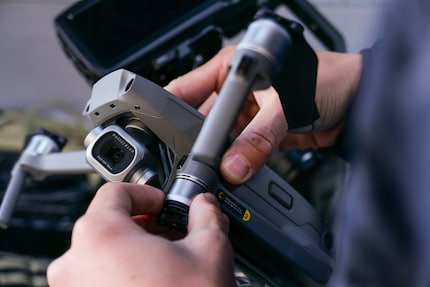
Thanks to its small size, the Mavic 2 Pro can be easily transported over long distances, for example to the boulder. The image quality is also impressive. Although it cannot take RAW images like the Blackmagic, it can still film with a colour depth of 10 bit. This allows more scope for colour post-processing. Other drones in this price range can display a maximum of 8 bit or 16 million colours (10 bit approx. one billion). Thanks to these properties, the two cameras can be better synchronised with each other later on.
Postproduction
I usually edit videos with Adobe Premiere Pro. Unfortunately, Premiere can't handle the files produced by the camera and their .braw extension. A plugin for 29 dollars provides a remedy. The free alternative is called DaVinci Resolve and comes from Blackmagic itself. A powerful tool that even professionals can use to cut their films and edit colours.
For once, I'm not editing this project in Premiere Pro, but in DaVinci Resolve. After a short period of familiarisation, I get to grips with the programme. I change my keyboard layout to Premiere Pro in the settings - so I quickly find my way around.
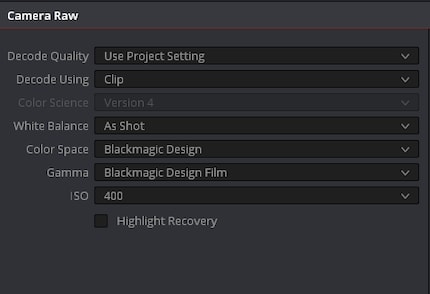
Thanks to the Blackmagic RAW files, the possibilities for colour editing are almost endless. White balance, ISO values, colour profile etc. can be changed afterwards without any loss of quality. More information about DaVinci can be found in this article:
Conclusion: price and performance are right
Here is the result: the video for this Galaxus article. It was filmed entirely with the Blackmagic Pocket Cinema camera and the Mavic 2 Pro. As described, the post-production was done exclusively with DaVinci Resolve.
As a Multimedia Producer, preparing multimedia content and knowing about cutting-edge technology is my business. My main focus at digitec is producing videos. I can’t wait to try out new products such as cameras, drones or smartphones as soon as they’re launched. This is where being at the source comes in rather handy. When I’m not working, I’m probably skiing, biking or hiking – the mountains are my place to be.





